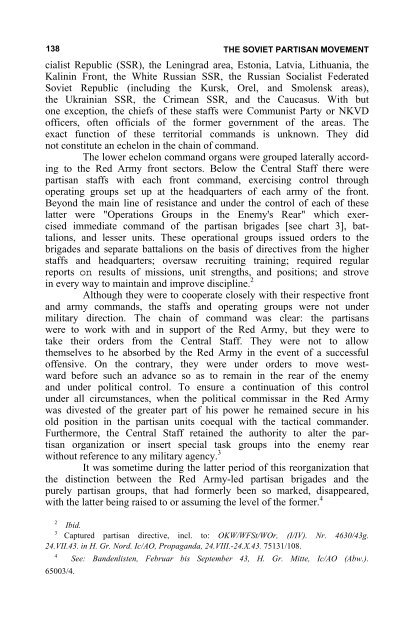the soviet partisan movement 1941-1944 by edgar m. howell
the soviet partisan movement 1941-1944 by edgar m. howell
the soviet partisan movement 1941-1944 by edgar m. howell
Create successful ePaper yourself
Turn your PDF publications into a flip-book with our unique Google optimized e-Paper software.
138 THE SOVIET PARTISAN MOVEMENT<br />
cialist Republic (SSR), <strong>the</strong> Leningrad area, Estonia, Latvia, Lithuania, <strong>the</strong><br />
Kalinin Front, <strong>the</strong> White Russian SSR, <strong>the</strong> Russian Socialist Federated<br />
Soviet Republic (including <strong>the</strong> Kursk, Orel, and Smolensk areas),<br />
<strong>the</strong> Ukrainian SSR, <strong>the</strong> Crimean SSR, and <strong>the</strong> Caucasus. With but<br />
one exception, <strong>the</strong> chiefs of <strong>the</strong>se staffs were Communist Party or NKVD<br />
officers, often officials of <strong>the</strong> former government of <strong>the</strong> areas. The<br />
exact function of <strong>the</strong>se territorial commands is unknown. They did<br />
not constitute an echelon in <strong>the</strong> chain of command.<br />
The lower echelon command organs were grouped laterally according<br />
to <strong>the</strong> Red Army front sectors. Below <strong>the</strong> Central Staff <strong>the</strong>re were<br />
<strong>partisan</strong> staffs with each front command, exercising control through<br />
operating groups set up at <strong>the</strong> headquarters of each army of <strong>the</strong> front.<br />
Beyond <strong>the</strong> main line of resistance and under <strong>the</strong> control of each of <strong>the</strong>se<br />
latter were "Operations Groups in <strong>the</strong> Enemy's Rear" which exercised<br />
immediate command of <strong>the</strong> <strong>partisan</strong> brigades [see chart 3], battalions,<br />
and lesser units. These operational groups issued orders to <strong>the</strong><br />
brigades and separate battalions on <strong>the</strong> basis of directives from <strong>the</strong> higher<br />
staffs and headquarters; oversaw recruiting training; required regular<br />
reports on results of missions, unit strengths, and positions; and strove<br />
in every way to maintain and improve discipline. 2<br />
Although <strong>the</strong>y were to cooperate closely with <strong>the</strong>ir respective front<br />
and army commands, <strong>the</strong> staffs and operating groups were not under<br />
military direction. The chain of command was clear: <strong>the</strong> <strong>partisan</strong>s<br />
were to work with and in support of <strong>the</strong> Red Army, but <strong>the</strong>y were to<br />
take <strong>the</strong>ir orders from <strong>the</strong> Central Staff. They were not to allow<br />
<strong>the</strong>mselves to he absorbed <strong>by</strong> <strong>the</strong> Red Army in <strong>the</strong> event of a successful<br />
offensive. On <strong>the</strong> contrary, <strong>the</strong>y were under orders to move westward<br />
before such an advance so as to remain in <strong>the</strong> rear of <strong>the</strong> enemy<br />
and under political control. To ensure a continuation of this control<br />
under all circumstances, when <strong>the</strong> political commissar in <strong>the</strong> Red Army<br />
was divested of <strong>the</strong> greater part of his power he remained secure in his<br />
old position in <strong>the</strong> <strong>partisan</strong> units coequal with <strong>the</strong> tactical commander.<br />
Fur<strong>the</strong>rmore, <strong>the</strong> Central Staff retained <strong>the</strong> authority to alter <strong>the</strong> <strong>partisan</strong><br />
organization or insert special task groups into <strong>the</strong> enemy rear<br />
without reference to any military agency. 3<br />
It was sometime during <strong>the</strong> latter period of this reorganization that<br />
<strong>the</strong> distinction between <strong>the</strong> Red Army-led <strong>partisan</strong> brigades and <strong>the</strong><br />
purely <strong>partisan</strong> groups, that had formerly been so marked, disappeared,<br />
with <strong>the</strong> latter being raised to or assuming <strong>the</strong> level of <strong>the</strong> former. 4<br />
2<br />
Ibid. <br />
3<br />
Captured <strong>partisan</strong> directive, incl. to: OKW/WFSt/WOr, (I/IV). Nr. 4630/43g.<br />
24.VII.43. in H. Gr. Nord. Ic/AO, Propaganda, 24.VIII.-24.X.43. 75131/108.<br />
4<br />
See: Bandenlisten, Februar bis September 43, H. Gr. Mitte, Ic/AO (Abw.).<br />
65003/4.
















